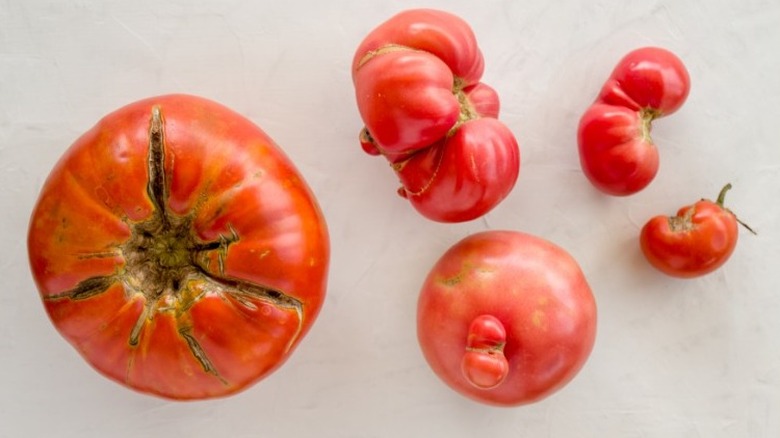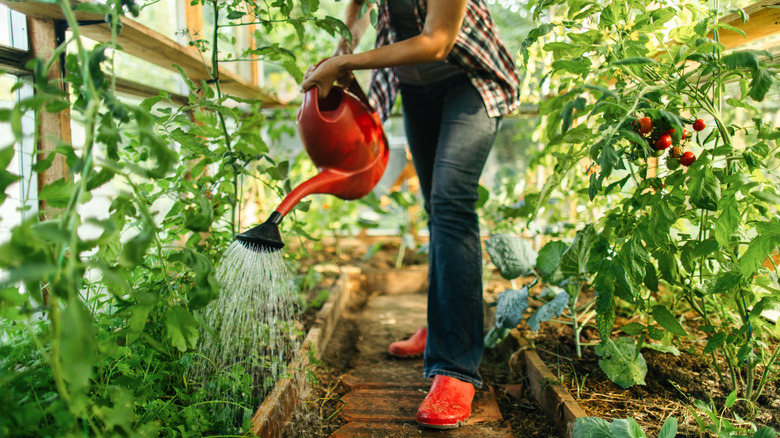What Really Happens When A Tomato Catfaces (And How To Use Them)
Tomatoes are one of the most popular garden staples, but as many gardeners know, not every tomato is picture-perfect. A tomato disorder called catfacing can make certain tomatoes look oddly scarred and puckered. If you're looking at your latest tomato harvest and wondering what happened to your freaky-looking tomatoes, this condition might be it. But what exactly causes catfacing, and can these tomatoes still be used?
Catfacing is characterized by the tomato's abnormal growth, where the fruit develops deep scars, crevices, and misshapen bulges. Contrary to its eerie name, this condition has nothing to do with cats (so don't blame it on Mr. Fluffy). Instead, it results from a combination of environmental and biological factors. According to research by the University of Maryland, one of the main culprits is the exposure to cold temperatures (below 50 degrees Fahrenheit) during the blossom set. Tomatoes are warm-season crops that need a soil temperature of at least 65 degrees. A sudden drop can damage the flowers' development, affecting normal growth and giving it that irregular Franken-tomato shape.
Inconsistent watering is another factor that can cause the fruit to develop abnormally. Tomatoes require consistent moisture, especially during the flowering and fruiting stages. Water-stressed plants might show more signs of catfacing. Oklahoma State University resources indicate that certain herbicides, like 2,4-D, can harm the tomato blossoms as well. Practices such as heavy pruning or excessive nitrogen fertilization can also contribute to higher rates of catfacing. All this damage can later manifest in the developing fruit.
What to do with a catfaced tomato
Even though they might not win a beauty contest, catfaced tomatoes are perfectly edible. The scarred and creviced portions can be cut away, and the rest of the tomato can be used as usual. In fact, some even argue that these tomatoes are more flavorful than their perfectly shaped counterparts.
Catfaced tomatoes are excellent for blended or mixed dishes, such as sauces and pastes. Simply chop them up, remove the scarred portions, and cook them down for a rich tomato base. Their unique appearance won't matter when they're part of a delicious soup or stew. While they might not look as pretty, once diced or chopped, they can also be added to salads just like any other tomato. If you have a surplus of catfaced tomatoes from your yield, consider freezing them for later use. Once thawed, they can be used just the same in various cooked, chopped, or blended dishes.
One important thing to do is thoroughly check your catfaced tomatoes for any open wounds after your harvest. Unfortunately, the stretched bits of catfaced tomatoes can sometimes literally break open, making them more vulnerable to uninvited guests like insect pests or, worse, pathogens such as black mold (via University of Massachusetts Amherst). If your tomato has any worrisome fungi rot, it's best to compost it. Otherwise, if the damage is small and superficial, you can simply cut it out before enjoying the fruit (tomato is botanically a fruit, but nutritionally, a vegetable).
How to prevent catfacing
The bad news is once your tomato has catface, it is pretty much incurable. The good news is that catfacing is largely preventable. Some tomato varieties are more susceptible to catfacing, such as Heirloom — usually, the bigger the tomato, the greater the potential defects. Thankfully, there are also resistant varieties, such as Countil, Monte Carlo, and Floradade. Research and opt for those varieties if catfacing has been a consistent problem in your garden.
Once you've chosen your tomato type, ensure you begin planting only after the last frost, when the soil has warmed up. If you live somewhere with irregular or cold temperatures (especially at night), consider growing your tomatoes in a greenhouse to ensure proper temperature control, especially during that critical phase of flower development. Using mulch around your tomato plants can also help increase the soil temperature to keep them warm and cozy. Make sure to provide consistent water throughout the growing process. Using a drip irrigation system or soaker hoses can help maintain steady moisture levels.
Catfacing will undoubtedly yield some ugly duckling tomatoes, which might seem like a bane for tomato lovers. However, understanding its causes and knowing that these tomatoes are still edible can make this benign condition a lot less daunting. Embracing these quirky fruits and incorporating them into various tasty dishes can truly be a testament to a gardener's adaptability and culinary creativity. As the adage goes, don't judge a tomato by its cover.


